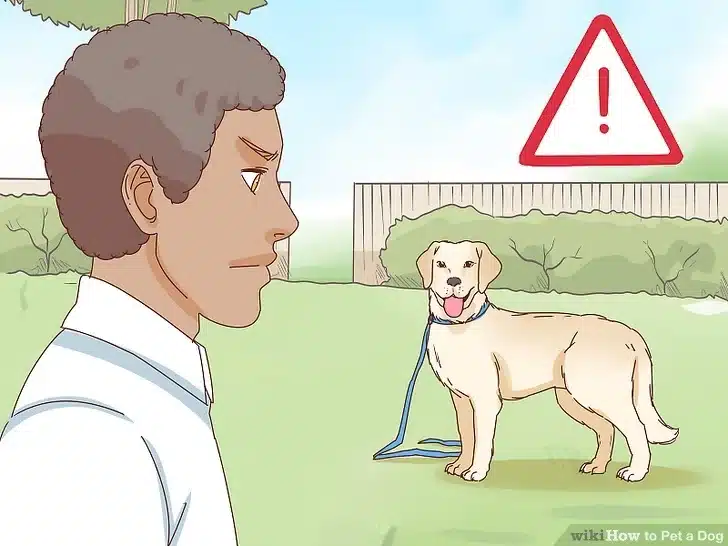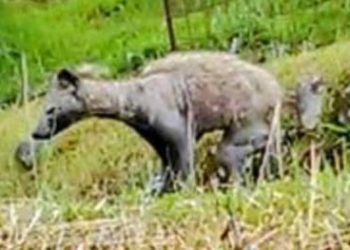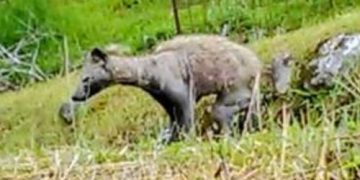Approaching a Dog Cautiously




Bend over or squat to invite dogs to approach. Invite the dog to take the first step by squatting down closer to their level. More confident dogs only require bending over slightly, but don’t bend directly over the dog, as this could make them feel threatened. Sometimes, you can help a dog to calm down by introducing yourself. Dogs introduce themselves to each other by sniffing. Humans introduce themselves to each other by shaking hands. This works with a human introducing themselves to the dog. The human holds out the back of their hand to the dog’s snout, and if it sniffs the hand, it will usually calm down.
- Never squat down near a dog without an owner or a dog that is acting aggressive (see the signs listed above). Remain standing to defend yourself in case the dog attacks.

Coax shy dogs closer. If squatting down still hasn’t attracted the dog, and it is acting shy or skittish (running away or hiding), look away since eye contact can be threatening.[1] Make gentle, quiet coaxing noises; it doesn’t matter what these are but avoid loud noises or noises that seem to startle the dog. Turn your body to one side to appear smaller and less threatening.
- Ask the owner for the dog’s name and use it to coax the dog. Some dogs have been trained to respond to the sound of their name, and they may be less shy or aggressive.

Hold out your fist. If the dog seems receptive to petting after these steps, or at least appears relaxed and shows no signs of aggression or discomfort, offer your fist for it to investigate. Hold your fist out towards its nose, but not directly against its face. Let the dog approach and sniff the back of your hand for as long as it likes.
- Do not offer your open hand, as an unfamiliar dog may bite your fingers, thinking they are treats.
- The dog sniffing you is evaluating you, not asking to be pet. Wait until the dog is done sniffing before moving on.
- Don’t worry if a dog licks you. It’s just the dog’s way of saying they trust you and have affection for you, similar to kissing for humans.

Petting an Unfamiliar Dog


Move on to other areas. If you have been successful up to this point, and the dog isn’t trying to shy away, continue to other areas. You may move your hand across the back, or move it to the crown, and gently scratch there with your fingers.
- Many dogs enjoy being scratched at the top of their back, on either side of the spine. The front end near the neck and shoulders has a lower chance of making the dog anxious than the back end near the tail and hind legs. Stay away from the dog’s legs, tail, and private parts.
- Friendly dogs may enjoy being pet under the chin or on the chest, but others dislike strangers reaching near their jaw.


Petting a Familiar Dog




Give the dog a thorough massage once in a while. Every so often, take 10 or 15 minutes to rub a familiar dog from head to tail. Use a circular motion to cover the dog’s face, under the chin, and chest. Move on to the top of the neck, the shoulders, and back all the way to the tail. Some dogs may let you massage down each of its legs.
- Besides giving the dog an enjoyable massage, this will help you keep track of which “bumps” are normal and always present, and which are newly developed and could be signs of health problems.

Massage dogs and puppies on their paws. Some dogs may not let you touch their paws, but if you can safely pick up the paws, gently rub them to improve circulation and locate grit or sharp objects causing the dog pain. If the pads of the paws appear cracked and dry, ask a veterinarian for a moisturizer suitable for dogs and rub that on your dog’s feet.[6]
- Massaging puppies on the feet can make later nail trimming much easier, as the puppies get used to having their feet touched.

Massage puppies in the mouth area. Young puppies may let you massage their mouth and feet if they know you well. Mouth massages often feel great for a teething puppy, and help the puppy get used to being handled here. This can make later dental work much easier.
- To massage a puppy’s mouth, gently rub the cheeks and jaw in a circular pattern. To massage its gums as well, use a “finger toothbrush” from a pet store or vet office.




















